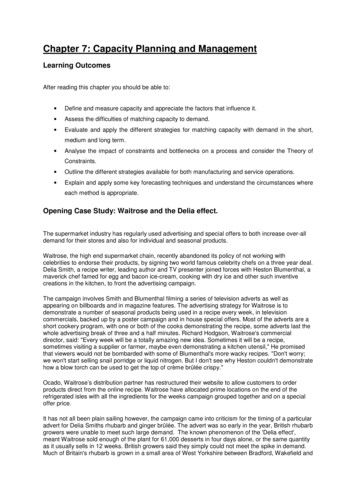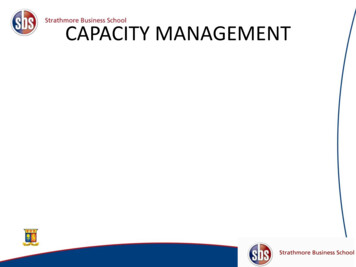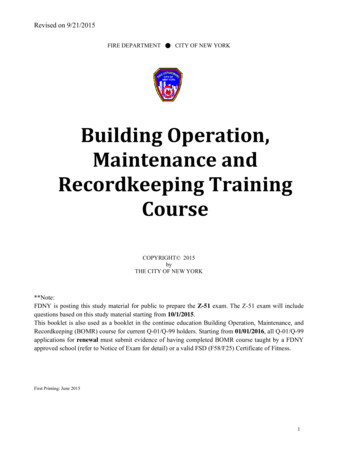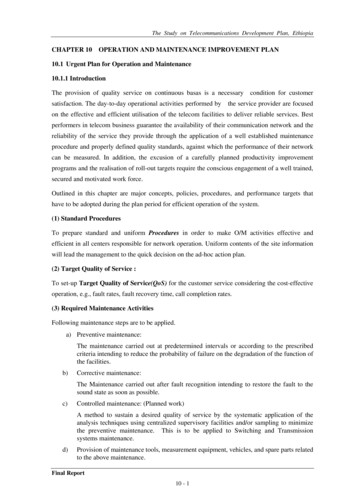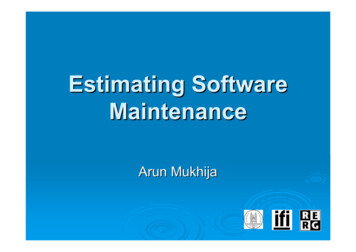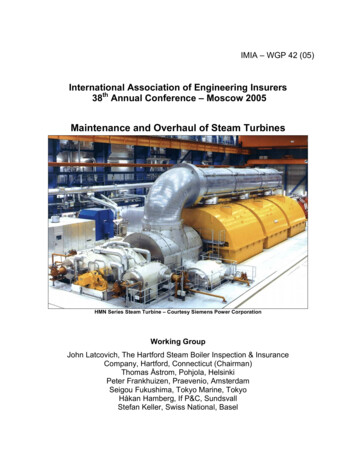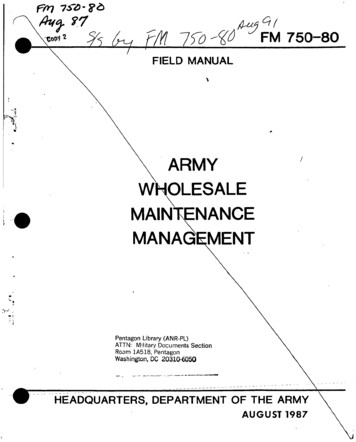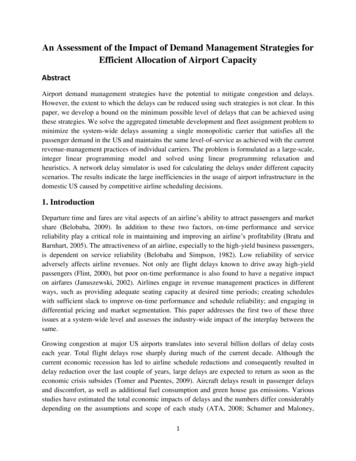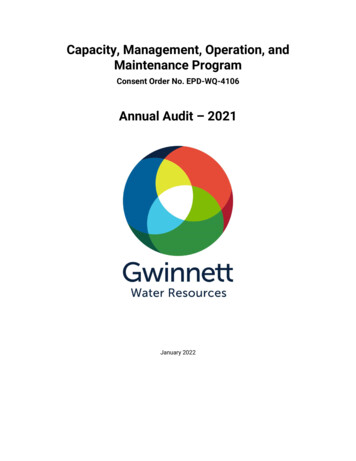
Transcription
Capacity, Management, Operation, andMaintenance ProgramConsent Order No. EPD-WQ-4106Annual Audit – 2021January 2022
GWINNETT COUNTY, GEORGIA – DEPARTMENT OF WATER RESOURCESCapacity, Management, Operation, and Maintenance Program SummaryJuly 2020 through June 2021Mission: Provide Superior Water Services at an Excellent ValueVision: To be widely recognized as a Leader in the Water Industry.The purpose of this document is to summarize the findings of our annual audit of the Capacity,Management, Operations, and Maintenance (CMOM) Program, which provides for the continuedoperation and management of Gwinnett County’s sanitary sewer collection system in anenvironmentally conscientious and cost-effective manner. This audit and summary complieswith the activities and reporting procedures required to document the progress of the programas outlined in Capacity, Management, Operations and Maintenance (CMOM) ConsentAgreement Guidance, Georgia Water Environment Federation, April 2006.The specific goals of the Gwinnett County CMOM Program are to:1. Minimize the possibility of sanitary sewer overflows (SSOs) from the Gwinnett CountyDepartment of Water Resources’ sewerage system;2. Document a response program to mitigate the effects of SSOs when they occur;3. Prioritize areas of the sewerage system that need to be addressed via short term andlong term solutions based in part on consideration of the frequency of SSOs in specificareas of the sewerage system;4. Document a spill reporting procedure that, at a minimum, ensures for proper reportingand posting of spills that occur from the Gwinnett County Department of WaterResources sewerage system in accordance with the Georgia Department of NaturalResources Environmental Protection Division’s (EPD’s) Rules and Regulations for WaterQuality Control;5. Provide firm schedules with major milestone dates for completion of sewerage systemimprovements as identified in the program;6. Provide a Capital Improvement Plan (CIP) that ensures for the ongoing funding ofsewerage system improvements;7. Document sanitary sewer system annual operating budgets that ensure that at least 25percent of each budget is earmarked for the implementation and administration ofCMOM components; and8. Provide regularly scheduled reports as defined in this program to the EPD to documentcompliance with the Gwinnett County Department of Water Resources’ program, asprovided in paragraphs (1) through (7) above.Page 2
1Table of Contents1Table of Contents. 32ORGANIZATION . 52.1Engineering & Construction (E&C): . 52.2Asset Management & Infrastructure Support (IS): . 52.3Field Operations: .52.3.1Corrective Maintenance Section: . 52.3.2Warehouse Section: . 52.3.3Contracts/Support Section: . 62.3.4Preventive Maintenance Section:. 62.434Facility Operations: .62.4.1Water Reclamation Section: . 62.4.2Pump Stations Section: . 62.5Technical Services .72.6Operations Technical Support (OTS): . 72.7Water Resources Laboratory: . 7LEGAL AUTHORITIES.83.1Infiltration/Inflow Control: . 83.2Sewer Design and Construction: . 83.3Inspection of New and Rehabilitated Sewers: . 83.4Satellite Systems: .83.5National Pretreatment Program: . 9MEASURES AND ACTIVITIES . 104.1Maintenance Facilities and Equipment: . 104.2Replacement Parts: .104.3Development and Maintenance of Collection System Maps: . 114.4Overflow Correction Prioritization: . 114.5Routine Preventive Operations and Maintenance:. 114.5.1Inflow/Infiltration Control: . 124.5.2Easement Clearing: .124.5.3Cleaning, Television Inspection, and Acoustic Assessment: . 124.5.4Manhole Location and Adjustment:. 134.5.5Grease Control: .134.6Sewage Pump Stations: . 144.7Pump Station and Meter Station Monitoring . 144.7.1Supervisory Control and Data Acquisition (SCADA): . 154.7.2Cellemetry: .15Page 3
54.8Communications: .154.9Remote Flow Meters: .164.10Training: .16DESIGN AND PERFORMANCE. 175.1Sewer and Pump Station Requirements and Standards: . 175.2Development Inspection Procedures and Specifications: . 175.2.16789Specification Provisions:. 17MONITORING, MEASURING, AND MODIFICATIONS . 196.1Metrics and Key Performance Indicators: . 196.2Program Updates: .196.3Program Summary: .19OVERFLOW EMERGENCY RESPONSE PLAN . 207.1Receipt of SSO Reports: . 207.2Response: .207.3Official Notification: .217.4Training: .217.5Emergency Operations: . 22SYSTEM EVALUATION AND CAPACITY ASSURANCE . 238.1Hydraulic Modeling: .238.2Master Plan: .238.3Capital Improvement Plan: . 238.4Rehabilitation Identification and Prioritization: . 24PROGRAM AUDIT – INTERNAL . 259.1Program Monitoring:.259.2Report Preparation: .25Appendix A – Data Collection Form . 26Appendix B – Organization .35Appendix C – Vehicles and Equipment . 36Appendix D – Warehousing .47Appendix E – Spill Calculation Procedures . 110Appendix F – Capital Improvement Plan . 124Page 4
2ORGANIZATIONGwinnett County’s sanitary sewer collection system is operated and maintained by theGwinnett County Department of Water Resources (GCDWR). The Department includes severalseparate but interactive divisions that are responsible for the varied activities undertaken by thedepartment.Appendix B shows organizational charts of the department divisions that are involved inCMOM implementation. It also shows those personnel who have wastewater collections systemoperator certification, and certification requirements for vacant positions. The identifiedworkgroups and a summary of their respective responsibilities are as follows:Engineering & Construction (E&C):This workgroup has the primary responsibility for the design and construction of thecollection system. This responsibility entails substantial project management, oversightof design consultants, oversight of construction work, as well as some in-house design.Engineering & Construction’s CMOM-related activities include the design, procurement,and inspection of new capital construction projects and large rehabilitation orreplacement projects associated with the collection system.Infrastructure Support (IS):This workgroup is responsible for the maintenance of the GIS databases and maps usedto display locations, attributes, and connectivity of the sewer system. InfrastructureSupport collects, compiles, and verifies new GIS data proposed to be added to the Countydatabases and incorporates this data into the base maps. In addition, they are responsiblefor coordinating between Planning and Development and Field Operations during theprocessing of variance requests. They also work with developers to assure that the sewerdemands associated with proposed developments are appropriately calculated andmodeled. This workgroup also maintains the Computerized Maintenance ManagementSystem (CMMS) used for sewer asset management.Field Operations:The Field Operations Division is comprised of separate sections with specific CMOMrelated functions and responsibilities as set out here.2.3.1 Corrective Maintenance Section:The Corrective Maintenance section is primarily composed of repair and hydrojet crews. CMOM-related functions include field inspections, maintenance and repairwork on gravity sewer pipelines, sewer manholes, sewer force mains, and sewer servicelaterals. They perform proactive hydro-jet flushing, complete reactive repairs, investigatecustomer complaints, mitigate and address SSOs, and respond to other emergencysituations.2.3.2 Warehouse Section:Although this section provides support for all the operations of GCDWR, theWarehouse Section provides fundamental services to those workgroups with directresponsibility for operation and maintenance of the collection system. Key supportfunctions include, purchasing and procurement, warehousing of parts, and coordinatingequipment maintenance. This group is also responsible for coordinating with the FleetManagement group to assure that the vehicles used by the department are properlyPage 5
maintained and are repaired in a timely manner. The Warehouse Section also providesand coordinates the daily operation of the Field Operations dump trucks to providedelivery and removal of soil, stone, and debris to and from work sites. Landscapingservices for completed repairs are managed through this Section to restore disturbedareas.2.3.3 Contracts/Support Section:This section supports the Field Operations Division in several different functions.This section manages the contracts for maintenance and rehabilitation of the sanitarysewer collection system including chemical root control treatments, manhole andpipeline rehabilitation, easement clearing, and sewer assessment. Additionally, thissection includes the Dispatch and Investigations group, which determines the nature andseverity of situations reported by customers and routes the issue to the appropriategroup. Typical job functions of this group include taking customer calls 24/7, monitoringpump station alarms after normal business hours, investigating customer calls, and areoften the first representatives of the department to arrive on-site.2.3.4 Preventive Maintenance Section:This section is responsible for assessment of existing publicly owned gravitysewer mains, sewer force mains, and privately installed sewer extensions proposed tobe added to the public system. CCTV inspections are performed to assess the internalcondition of the pipes proactively, as support for corrective measures, and followingbackups or SSOs. Other responsibilities include manhole condition assessment, criticalsewer crossing inspections, and I/I investigations. This section also includes the Fats,Oils, and Grease (FOG) Facility Inspection Program, which strive to prevent additionalgrease loading into the sewer system by food service establishments through educationand routine inspection of grease interceptors.Facility Operations:The Facility Operations Division is comprised of separate sections with specific CMOMrelated functions and responsibilities as set out here.2.4.1 Water Reclamation Section:This section is responsible for the operation and maintenance of the County’swastewater treatment facilities. Primarily this section ensures the proper andcontinuous operation of the mechanical, chemical, and biological treatment processesfor the wastewater in compliance with the permitted operations of the facility.This section is also responsible for implementation of reactive, routine,predictive, and preventive maintenance of the facilities. They are responsible fordocumenting and reporting the status of compliance with regulations and permitrequirements to the appropriate authorities and agencies.2.4.2 Pump Stations Section:This section maintains and monitors the performance of the County-owned andoperated pump stations which control the transfer of sanitary sewer flows between themechanical portions of the system and the gravity-driven collection system pipes. Thissection is also responsible for inspecting air release valves. The section also ensuresPage 6
the proper design, construction, and operation of privately installed pump stations, whichare proposed to be dedicated to the County system.Technical ServicesThis workgroup is convened as needed to address departmental-level issues and is notcontinuously involved in the daily operation of the utility. This workgroup is made upprimarily of the Director, Assistant Director, Deputy Directors, and several of theDepartmental Division Directors. Other staff members are added as appropriate toeffectively address the issue under consideration. The workgroup has departmental-levelresponsibility for identifying, quantifying, and planning for future sewer needs, supportingstate and federal permitting, issuing construction permits for sewer extensions, andmonitoring developing regulatory concerns. CMOM-related activities that the strategicplanning workgroup has responsibility for include Wastewater Master Plan, CIPdevelopment, prioritizing CIP projects across divisions, and reviewing and permitting newsewer extensions proposed by developers and other private entities.Operations Technical Support (OTS):This workgroup identifies, delineates, and prioritizes collection system CIP projects fortransfer to E&C. In addition, it manages the contractors performing installations,relocations, and maintenance of the collection system flow meters. Operations TechnicalServices also identifies condition assessment needs for implementation by FieldOperations crews and performs analyses to develop forecasts of future rehabilitationneeds and asset performance. In addition, they are responsible for the maintenance andupkeep of the sewer model and evaluates proposed system improvements. The modelingperformed by this work group defines the current state of the collections system.Water Resources Laboratory:The Water Resources Laboratory is responsible for laboratory analyses for waterproduction and water reclamation. Additionally, this section manages the IndustrialPretreatment Program, including permitting, monitoring, and enforcement. CMOM-relatedactivities that the Water Resources Laboratory has responsibility for includeadministration of the pretreatment program and water quality sampling. This group isresponsible for testing water samples and reporting the results to the EnvironmentalProtection Division following a major sanitary sewer spill.Page 7
3LEGAL AUTHORITIESOn September 1, 1998, the Gwinnett County Board of Commissioners adopted an ordinancefor sewage collection, treatment, and construction. This ordinance, generally known as the“Sewer Use Ordinance”, sets forth uniform requirements for contributors into the wastewatercollection and treatment system from Gwinnett County, Georgia and enables the County tocomply with all applicable state and federal laws required by the Clean Water Act of 1977,amendments to this Act, and the general pretreatment regulations (40 CFR Part 403). Specificprovisions of this Sewer Use Ordinance are documented in Chapter 106, Article III of theGwinnett County Code of Ordinances on the Municode Library (Municode). This ordinanceaddresses many topics including but not limited to the following.Infiltration/Inflow Control:Section 106-126(a)(2)a.11 Prohibits the discharge of “Stormwater, surface water,groundwater, roof runoff, subsurface drainage, swimming pool drainage, unless specificallyauthorized by the director.”Sewer Design and Construction:Section 106-98(a) provides that “All extensions of the sewer system shall be designedand built in accordance with current DWR standards. The standards shall be those stated in thelatest edition of "WATER MAIN AND SANITARY SEWER DESIGN AND CONSTRUCTIONSTANDARDS AND SPECIFICATIONS", which is available at DWR and at the Department ofPlanning and Development. No installation of pipe or other materials for sewer extensions shallbe allowed until the required information is received and the design is approved by the County.Inspection and acceptance procedures shall be specified in these standards.”Standards for the design and construction of sanitary sewer pump stations and forcemains are also published and set forth in a standard document which is available directly fromthe County website.Inspection of New and Rehabilitated Sewers:The Gwinnett County sanitary sewer standards provide minimum acceptable criteria formaterials, construction, testing, and installation of sewer lines that are applicable to both newand rehabilitated public sewers.Section 106-96(d) provides that “Permanent easements for sewer facilities are for thecounty to install, inspect, observe, measure, sample, repair, protect, maintain and operate anyportion of the sewer facilities lying within such easement. It is essential that access to theeasement not be obstructed ”Satellite Systems:Section 106-129(g)(1) provides that “If a municipality, other county, or user locatedwithin another municipality or county, contributes wastewater to the POTW, the director shallenter into an intergovernmental agreement with the contributing municipality or county.”Section 106-129(g)(3)a. provides that “A requirement for the contributing municipality orcounty to adopt a sewer use ordinance which is at least as stringent as this division and locallimits, including required BMPs, which are at least as stringent as county local limits. Therequirement shall specify that such ordinance and limits must be revised as necessary to reflectchanges made to the county's ordinance or local limits;”Page 8
National Pretreatment Program:Chapter 106-Article III-Division 2 implements the general and specific prohibitions ofState and Federal Laws including the National Pretreatment Program (40 CFR 403). Thesesections incorporate the National Pretreatment Standards by reference and set forth local limitson pollutants discharged by system users as well as monitoring and reporting requirements.Page 9
4MEASURES AND ACTIVITIESThe Department of Water Resources is committed to earmarking 25 percent of theannual sanitary sewer system operating budget for the implementation and administration ofCMOM components, refer to Appendix A- XVIII.Maintenance Facilities and Equipment:The Department of Water Resources maintains a 118,000 sq. ft. facility for centraladministrative, engineering, planning, and maintenance operations, located at 684 WinderHighway, Lawrenceville, GA. Opened in 2000, this facility provides office and assemblyaccommodations for maintenance operations along with a 20,000 square foot warehouse,4,000 square foot detached storage building, a 224,000 square foot storage yard, an 11 baydetached garage for storing the hydro-jet trucks, and mechanical and electrical shops forequipment and minor vehicle repair.In 2013 a separate pump station building was constructed on the central facility toprovide a space specifically dedicated to the operation and maintenance of pump stations. Thisfacility is used for pump station component maintenance and storage and to house pumpstation vehicles and equipment.GCDWR maintains an adequate heavy equipment inventory to fully equip repair crewsincluding: manhole maintenance/repair crews, sewer pipe maintenance/repair crews, hydro-jetcrews, and pump station repair crews. GCDWR also maintains vehicles and specialty equipmentto fully equip CCTV inspection crews, acoustic inspection crews, electronic technicians, andodor control specialists. The collections workgroup’s passenger vehicle inventory is adequate tosupport field coordinators, contract managers, inspectors, and field technicians. In addition,GCDWR maintains an inventory of stand-by emergency equipment that includes heavy-dutyservice and repair vehicles, portable generators, pumps, ATVs, light plants, message boards,and arrow boards.Appendix C contains a more comprehensive list of County vehicles and equipmentassigned to the collections system operation and maintenance. The maintenance of vehicles,heavy equipment, and other motorized equipment is centralized countywide through GwinnettCounty’s Department of Support Services – Fleet Management Division (GCFMD).Replacement Parts:The Department of Water Resources maintains a fully stocked warehouse with allnecessary materials required to make emergency repairs on the collection system and to carryon the daily operations of the workgroups responsible for the operation and maintenance of thecollection system. Pipe, repair clamps, closure pieces, transition couplings, and similar repairmaterials are stocked for all sizes of pipelines and force mains in the collection system.The department also operates the potable water system and stormwater system, andmany parts are interchangeable. GCDWR has standardized on one manufacturer of submersiblepumps, limiting the amount of replacement parts inventory needed. Replacement parts arestocked for the most common types of failures experienced in pump stations, including controlsystems, valves, vacuum prime systems and electrical components. A representative sample ofitems stocked in the warehouse is attached as Appendix D.As GCDWR has pump stations up to 30 MGD, it is not economically feasible to stockreplacement pumps, motors, starters and complete valves for the larger sized facilities,however; in the preparation of project specifications and purchase of equipment, priority isPage 10
given to vendors who maintain local service facilities and local inventories of spare parts for theequipment they propose to provide.The design of the facilities also provides redundancy to allow for the service and repairof failed equipment. The warehouse manages replacement parts through the inventory controlsystem. This software tracks the usage of the parts and notifies inventory personnel when theremaining quantities reach a pre-set reorder point. The parts are then replenished through theprocurement process.Development and Maintenance of Collection System Maps:All sewer lines, manholes, pump stations, and related appurtenances have been digitizedin a Geographic Information System (GIS). Additionally, paper as-built drawings have beenscanned into an Electronic Document Management System (EDMS) and attached to thefeature(s) to which they relate in the GIS. This enables the user to select a collection systemfeature in the GIS and retrieve an electronic copy of the as-built drawings for it. In addition,GCDWR has implemented a computerized maintenance management system (CMMS) whichcan track work orders and CMOM related activities by asset. These CMOM activities include:inspections, maintenance, rehabilitation, and emergency calls. The CMMS is integrated with theCounty’s GIS.The Department of Water Resources has collected survey grade GPS coordinates,inverts and rim elevations on the critical sewer structures in our collection system to improvethe accuracy of our GIS and sewer model. It is also required by GCDWR for the as-built drawingsof any significant sewer improvements, extensions, or repairs to be submitted with associatedGIS data. This data is prepared in a format and to a level of detail matching the Departmentdatabases to allow direct import of this information and update of the base maps. However, allassets are field verified before the as-built drawings are scanned into the EDMS and uploadedto GIS. The data collection
improvements as identified in the program; 6. Provide a Capital Improvement Plan (CIP) that ensures for the ongoing funding of sewerage system improvements; 7. Document sanitary sewer system annual operating budgets that ensure that at least 25 percent of each budget is earmarked for the implementation and administration of CMOM components; and 8.

